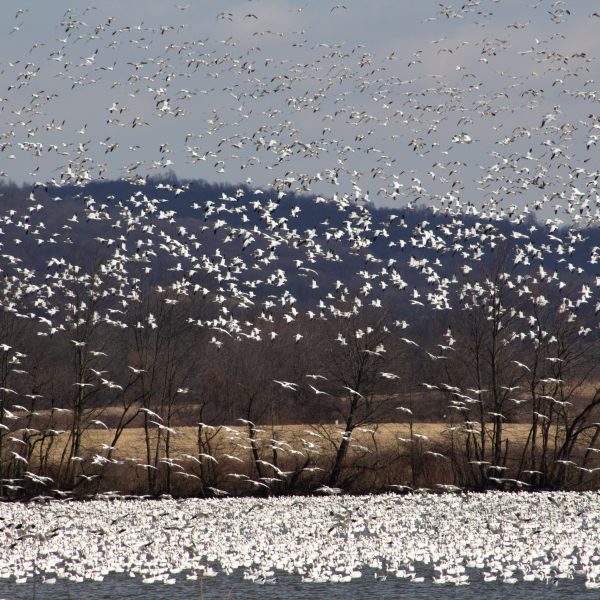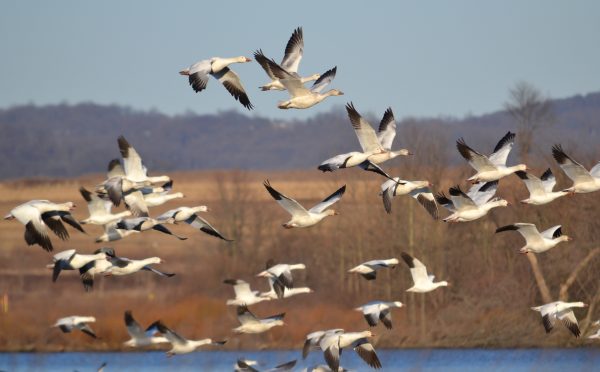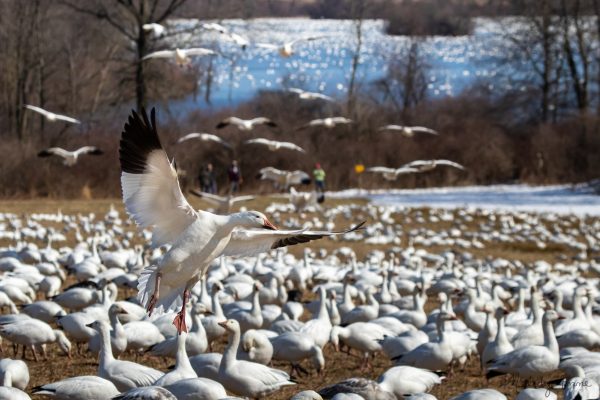By Brant Portner | Environmental Education Specialist
Middle Creek Wildlife Management Area | Pennsylvania Game Commission
![]()
From approximately mid-February to mid-March, large patches of snow seem to appear on farm fields in Lebanon County. This wouldn’t be too abnormal, except these patches of snow move, even fly! Usually snow falls down, not up. That’s because this snow I’m talking about is actually large groups of birds – snow geese.
One of Lebanon County’s most popular and well-known biological spectacles happens just on the southern edge of the county. Located south of the village of Kleinfeltersville is  a place called Middle Creek Wildlife Management Area. Middle Creek is owned and operated by the Pennsylvania Game Commission, the state’s wildlife agency, and comprises of nearly 6,000 acres of public land, of which roughly 1,000 acres lie in Lebanon County.
a place called Middle Creek Wildlife Management Area. Middle Creek is owned and operated by the Pennsylvania Game Commission, the state’s wildlife agency, and comprises of nearly 6,000 acres of public land, of which roughly 1,000 acres lie in Lebanon County.
In 2018, an estimated 200,000 snow geese were on Middle Creek’s main lake on one single day. For years now, the numbers of snow geese on the lake at their peak have floated well over 100,000. You can imagine how that would be quite the event to witness. It hasn’t always been that way, as Middle Creek was created primarily for waterfowl habitat and it took years for the snow geese and other birds, such as tundra swans, to catch on. Now in 2023, our 50th year of being open to the public, there is no better time to come explore Middle Creek and the surrounding area.
So why does this spectacle of snow geese happen in Lebanon County? Besides the obvious draw of a big lake and excellent waterfowl habitat that was created 50 years ago that is continuously managed for wildlife, it’s only just a pit stop on their northern spring migration. Earlier in the year, they overwinter around the mid-Atlantic coast, especially the Chesapeake Bay, then start to move north over southeast and central Pennsylvania. The Lebanon Valley’s rich agricultural resources provide vital places for snow geese to stop and forage on cover crops such as winter wheat. They “roost” overnight on the Middle Creek Reservoir (pictured right), which provides some protection from predators that may be lurking on the land looking for a meal. Once they fill up on some food and get some rest, they are ready to continue their journey north. The next concentrated stop over is generally in the Finger Lakes area of New York, including Montezuma National Wildlife Refuge. In the fall, they migrate mostly south along the coast and not overland, which is why you don’t see them locally.
 So, how do you get in on the action? If you’re looking to check out the major migration this spring, there are some tips to avoid the big crowds. If the weather is nice on a weekend, it’s likely crowds will be big and parking hard to find. Therefore, we recommend visiting Willow Point (which is the best place to view them and just off Hopeland/Kleinfeltersville Road) at either dawn or dusk on weekdays. Although it can be tough to get out of bed to see snow geese on a cold morning, it is well worth it. When the geese roost on the water overnight, they are very concentrated on the water. From a distance, it sometimes looks like a big floating chunk of ice! Often times, many will leave the lake at dawn in their family groups to go forage for food. This flurry of activity is the best part of watching snow geese. Thousands will take off at once and fly right overhead. This is quite a noisy event. Likewise, when the snow geese are returning in the evening to roost, thousands are simultaneously landing on the water. Of course, many are coming and going from the lake during the day, but dawn and dusk really have the most concentrated action to witness.
So, how do you get in on the action? If you’re looking to check out the major migration this spring, there are some tips to avoid the big crowds. If the weather is nice on a weekend, it’s likely crowds will be big and parking hard to find. Therefore, we recommend visiting Willow Point (which is the best place to view them and just off Hopeland/Kleinfeltersville Road) at either dawn or dusk on weekdays. Although it can be tough to get out of bed to see snow geese on a cold morning, it is well worth it. When the geese roost on the water overnight, they are very concentrated on the water. From a distance, it sometimes looks like a big floating chunk of ice! Often times, many will leave the lake at dawn in their family groups to go forage for food. This flurry of activity is the best part of watching snow geese. Thousands will take off at once and fly right overhead. This is quite a noisy event. Likewise, when the snow geese are returning in the evening to roost, thousands are simultaneously landing on the water. Of course, many are coming and going from the lake during the day, but dawn and dusk really have the most concentrated action to witness.
We also recommend dressing for the weather and bringing food and water. Although it is technically spring, it often won’t feel like it. Sometimes real snow can accompany the snow geese and it can get windy at Willow Point. If you’re waiting for a while to get the perfect picture or see the most action, you will likely get hungry or thirsty! Luckily, Kleinfeltersville and Schaefferstown are a short drive away and do have some shopping and dining opportunities.
If you’ve gotten cold, another way to warm up is to stop by the Visitors Center mile south from Willow Point. The Visitors Center has a display of many different bird and mammal species, interactive displays, windows, and binoculars to watch songbirds, and a new Conservation Heritage Museum that just opened last summer. Middle Creek also features nearly a dozen hiking trails and other wildlife viewing opportunities during this early spring season. Besides snow geese, many other large migrating species will also be gracing the water and fields, such as tundra swans, Canada geese, and many species of ducks. Often times, bald eagles are flying overhead keeping an eye out for an easy meal. If you come back at another time of year, the snow geese may have moved on, but nature always has surprises and discoveries waiting to be made in every season! For our 50th anniversary, we have an activity challenge that can be completed for a free decal sticker. More information on snow goose migration and Middle Creek can be found on the Game Commission’s website online at PGC.PA.GOV.
from Willow Point. The Visitors Center has a display of many different bird and mammal species, interactive displays, windows, and binoculars to watch songbirds, and a new Conservation Heritage Museum that just opened last summer. Middle Creek also features nearly a dozen hiking trails and other wildlife viewing opportunities during this early spring season. Besides snow geese, many other large migrating species will also be gracing the water and fields, such as tundra swans, Canada geese, and many species of ducks. Often times, bald eagles are flying overhead keeping an eye out for an easy meal. If you come back at another time of year, the snow geese may have moved on, but nature always has surprises and discoveries waiting to be made in every season! For our 50th anniversary, we have an activity challenge that can be completed for a free decal sticker. More information on snow goose migration and Middle Creek can be found on the Game Commission’s website online at PGC.PA.GOV.
